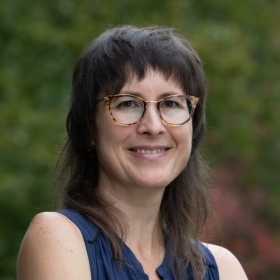A few years into teaching her constantly oversubscribed course on culture and mental illness, Holly Walters, a visiting lecturer in anthropology, noticed something interesting about the students in the class. “I started to realize that the mix of the student body that I was getting was much more diverse than just anthropology majors,” she says.

A few years into teaching her constantly oversubscribed course on culture and mental illness, Holly Walters, a visiting lecturer in anthropology, noticed something interesting about the students in the class. “I started to realize that the mix of the student body that I was getting was much more diverse than just anthropology majors,” she says. There were also students studying psychology, religion, and, increasingly, neuroscience. The realization prompted her to revamp the course, with input from colleagues in psychology and neuroscience, creating ANTH 236: Divine Madness: Dreams, Visions, Hallucinations.
“It’s still a primarily anthropology and religion course, but now brings in perspectives like, what is neuroscience and psychiatry’s answer to this? What is the criticism that anthropology has of religion? What is religion’s criticism of neuroscience? What is neuroscience’s criticism of anthropology?” Walters says. Ultimately, the course introduces students to a conversation among different disciplines. “That’s what I tell them on day one—this is not a course about answers, and sometimes that can be very frustrating. This is a course about helping you to understand that there is a conversation about this, and that there are very different views.”
An overarching question that the class asks is, what is a diagnosis? For example, they look at the diagnostic category of schizophrenia. “We look at the criteria that goes into it, and then ask the question, if schizophrenia looks different in a different culture—which it does—is it schizophrenia? Is this the same thing phenomenologically, or is this just something we call by the same name? … Once you start to look at diagnostic categories not as objects or things that exist in the world, but as methods of talking about an experience, you begin to see how culture begins to play an integral role in what even mental illness is,” she says.
One of Walters’ favorite lectures is about hysteria. “We talk about the rise of hysteria in the Victorian world, the idea of hysteria as flawed womanhood, particularly as broken womanhood, and how the Victorians pathologize gender. That usually very much resonates with a lot of my students at Wellesley,” Walters says. From there, the class discusses moral panic around gender and sexuality, which continues today, and which Walters calls direct outcroppings of hysteria. “They use the same arguments. They come from the same medicalization,” she says.
Walters suspects that one reason that her course is so popular is that mental illness touches almost everyone’s life in some way. But in the end, students discover that the class is about much more than mental health. “The course fundamentally gets at the question: How do you know what you think you know? … If someone is making claims that this is how the world works, and this is an objective fact, and this is how we know it’s an objective fact, [the course] gives students a cognitive toolkit that says, but is that actually true?”
[substory:1]

